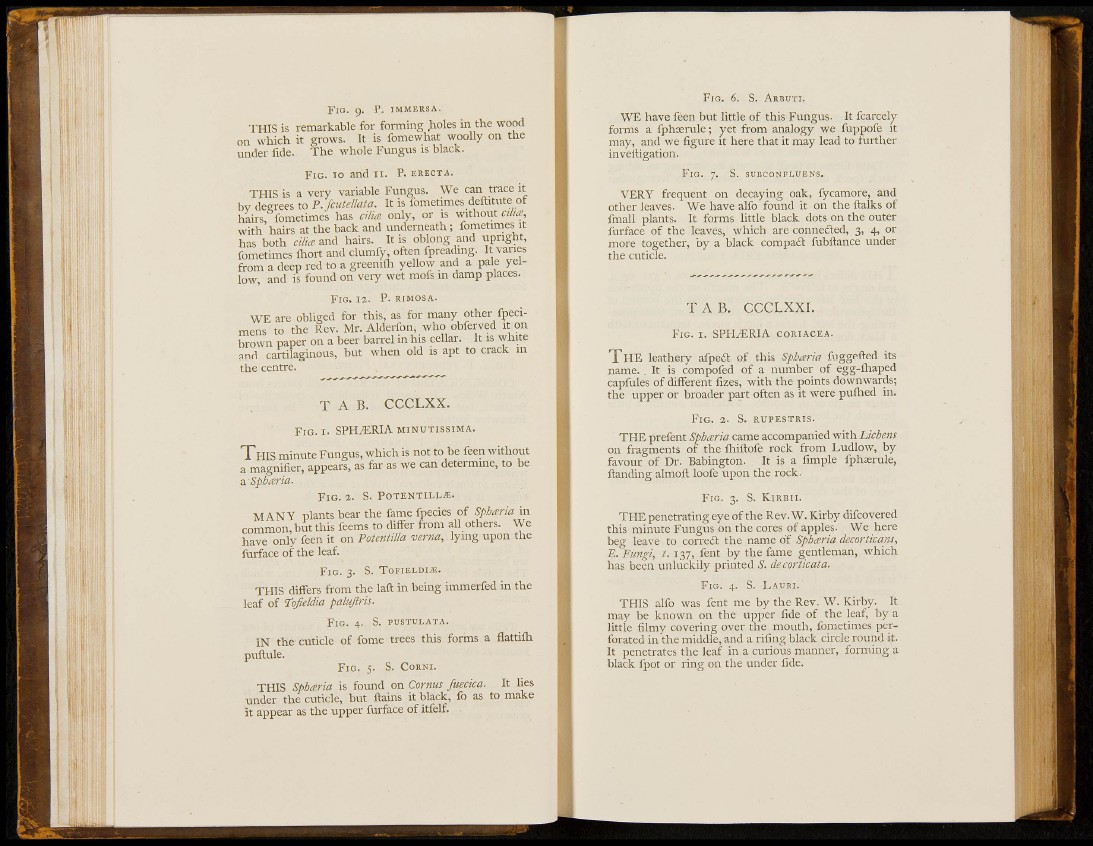
F I G . g. P. IMMERSA.
THIS is remarkable for forming holes in the wood
on which it grows. It is fomewhat woolly on the
under fide. The whole Fungus is black.
F I G . 10 and i i . P. ERECTA.
THIS is a very variable Fungus. We can trace it
by degrees to P. fcutellata. It is fometimes deftitute of
hairs, fometimes has cilia only, or is without aha:
with hairs at the back and underneath; fometimes it
has both a7/^and hairs. It is oblong and upright,
fometimes lliort and clumfy, often fpreading. It vanes
from a deep red to a greeniflr yellow and a pale yellow,
and is found on very wet mofs in damp places.
FIG. 12. P. SIMOSA.
WE are obliged for this, as for many other fpedmens
to the Rev. Mr. Alderfon, who obferved it on
brown paper on a beer barrel in his cellar. It is white
and cartilaginous, but when old is apt to crack in
the centre.
T A B . CCCLXX.
FIG. I. SPH^RIA MINUTISSIMA.
T H I S minute Fungus, which is not to be feen without
a magnifier, appears, as far as we can determine, to be
FIG. a. S. P0TENTILL.E.
MANY plants bear the fame fpecies of Spbaria in
common, but this feems to differ from all others. We
have only feen it on Potentilla verna, lying upon the
furface of the leaf.
F I G . 3. S. TOFIELDI«.
THIS differs from the laft in being immerfed in the
leaf of Tojieldia palujlrh.
FIG. 4. S. PUSTULATA.
IN the cuticle of fome trees this forms a flattifti
puftule.
F I G . 5. S. CoRNi.
THIS Spharia is found on Cornus fuecica. It lies
under the cuticle, but ftains it black, fo as to make
it appear as the upper furface of itfelf.
i<i 1
FIG. 6. S. ARBUTI.
WE have feen but little of this Fungus. It fcarcely
forms a fphaerule; yet from analogy we fuppofe it
may, and we figure it here that it may lead to further
inveftigation.
F I G . 7. S. SUBCONFLUENS.
VERY frequent on decaying oak, fycamore, and
other leaves. We have alfo found it on the ftalks of
fmall plants. It forms little black dots on the outer
furface of the leaves, which are conneited, 3, 4, or
more together, by a black compaa fubftance under
the cuticle.
T A B. CCCLXXI.
F I G . I. SPHARIA CORIACEA.
T H E leathery afpeft of this Spbceria fuggefted its
name. . It is compofed of a number of egg-lhaped
capfules of different fizes, with the points downwards;
the upper or broader part often as it were puflied in.
F I G . 2. S. RUPESTRIS.
THE prefent Sphieria came accompanied with Lichens
on fragments of the fliiftofe rock from Ludlow, by
favour of Dr. Babington. It is a fimple fphasrule,
ftanding almoft loofe upon the rock.
F I G . 3. S. KIRBII.
THE penetrating eye of the Rev. W. Kirby difcovered
this minute Fungus on the cores of apples. We here
beg leave to correil the name of Spbaria decorticam,
E. Fungi, t. 137, fent by the fame gentleman, which
has been unluckily printed S. decorticata.
F I G . 4. S. LAURI.
THIS alfo was fent me by the Rev. W. Kirby. It
may be known on the upper fide of the leaf, by a
little filmy covering over the mouth, fometimes perforated
in the middle, and a rifing black circle round it.
It penetrates the leaf in a curious manner, forming a
black fpot or ring on the under fide.
t:
:-V i